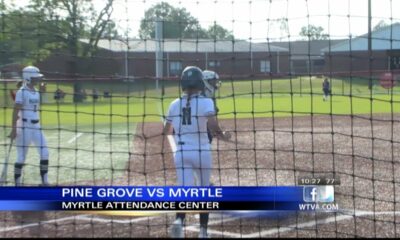Kaiser Health News
A Decades-Long Drop in Teen Births Is Slowing, and Advocates Worry a Reversal Is Coming
Catherine Sweeney, WPLN
Tue, 26 Sep 2023 09:00:00 +0000
NASHVILLE, Tenn. — Cicely Wilson's work doesn't end when she leaves her day job as a lactation consultant, doula, and child care expert.
Wilson founded a nonprofit called Sunnyside Up Youth Pregnancy Services, which connects girls ages 13 to 19 with resources they need to care for their babies. After-hours, she looks for affordable Nashville apartments, books medical appointments, tries to find strollers and other baby supplies, and hosts conversations with pregnant teens about breastfeeding and preparing mentally for childbirth.
Since the overturning of Roe v. Wade just over a year ago, Wilson said, she is confident that more Tennessee teens will carry their pregnancies to term. “Because the access isn't there,” she said. “I do anticipate that we're going to get a lot more teens that are wanting to parent their babies rather than going to Illinois or Georgia or Florida.”
Demand for services like Wilson's could rise in the coming years even though the national teen birth rate has declined dramatically over the past three decades. It's still dropping, but preliminary data released in June by the Centers for Disease Control and Prevention shows the descent may be slowing.
Doctors, service providers, and advocates say they're worried full CDC data released later this year — which will include state-by-state numbers — could show a rise in teen births in many Southern states, where rates remain among the highest in the country. They say several factors — including the Supreme Court's decision to strike down federal protections for abortion rights, intensifying political pushback against sex education, and the impact of the covid-19 pandemic on youth mental health — could start to unravel decades of progress.
“It's absolutely concerning,” said Laura Andreson, an OB-GYN in Franklin, Tennessee. The women's health practice where she works is treating more pregnant teenagers than in recent years, which she thinks could reflect an emerging trend.
“It's probably going to take a little bit of time,” she said. “But I would venture to say we're going to see it every year: It's going to go up.”
Nationally, the rate of teen births has dropped by 78% since a modern-day peak in 1991 of 61.8 births per 100,000 people, according to the CDC. Starting in 2007, the rate had consistently dropped by about 8% until 2021, when the rate of decline slowed to about 2%.
“It certainly does stand in contrast to what we've seen in prior years,” said CDC researcher Brady Hamilton. He is working on the updated version of the national data released in June that will break it down by state. Hamilton said that he can't comment on the recent social and political factors at play, but that the “phenomenal decline” in the teen birth rates over more than 15 years could be reaching a natural plateau as states achieved their goals.
“There are a lot of states that have very low birth rates,” he said. “So you kind of potentially run into a situation where they're already low and you really can't go lower.”
But advocates say this leveling off could be the writing on the wall, signaling the start of a rise in teen births.
“We know that young people came back from the pandemic with record levels of mental health struggles, which can be very tied to things like teen pregnancy,” said Jen Biundo, senior director of research and policy at Healthy Futures of Texas, a nonprofit that advocates for science-based education to curb teen pregnancy. A person with mental health issues may be more likely to form unhealthy relationships and engage in riskier sexual behaviors, she said.
And the decision to strike down abortion rights unleashed a sea change of legislation across the nation affecting reproductive health and options for women. States like Tennessee enacted so-called trigger laws, overturning the right to most abortions. In August, an all-male South Carolina Supreme Court upheld what abortion opponents sometimes call a “fetal heartbeat law,” which bans most abortions after about six weeks of pregnancy. The term is a misnomer because a fetus' heart is not fully developed in the early stages of pregnancy.
The sudden shift in the reproductive health landscape concerns Hannah Lantos, a researcher who specializes in maternal and adolescent health for Child Trends, a nonprofit research center. She said changes in abortion policy likely won't have major effects on teen birth statistics because most abortion patients aren't teenagers. Teenagers account for only 9% of abortions and 6% of all pregnancies reported in the U.S. each year, according to a report by Child Trends. Yet about 1 in 4 teens who do get pregnant in the U.S. will opt for an abortion, according to the Department of Health and Human Services.
Previous declines in the teen birth rate weren't driven by access to abortions alone, Lantos said. Other factors like increased access to and more effective contraceptive methods and sex education contributed. Now, those tools also are under siege in many states.
In Texas, some school boards have banned sex education curricula amid backlash from parents. In New Hampshire, Republican state officials blocked more than $600,000 in federal sex ed funding, and officials in Miami-Dade County, Florida, banned new sex ed books. In Idaho, lawmakers told the state's health departments the state would no longer fund adolescent pregnancy prevention programs.
Parents who oppose abortion could prevent their children from getting one. Even if the parents acquiesce, incentive for a teen is low, said Wilson of Sunnyside Up. People might need to travel hundreds of miles for abortion care now. That's particularly tricky for teenagers, who may be too young to make decisions independently.
“That car ride can be very excruciating,” Wilson said, noting that the drive from Nashville to the nearest abortion clinic — in Carbondale, Illinois — can take seven hours. “That's seven hours of potential silence. That's seven hours of tension. That's seven hours of thinking about what's next. And that is a long time to process something so difficult.”
The fear of a disapproving parent might also prevent a teenager who decides to keep the baby from revealing the pregnancy early on, Andreson said. That could lead to a lack of prenatal care, which is concerning for teens, given they are more likely to have complications than other expectant mothers.
“Their bodies aren't designed to have babies yet,” she said. “And this doesn't even go into all the issues that go on once the baby's born.”
Wilson, from Sunnyside Up, noted that teenage parents face unique challenges taking care of newborns. “It's a lot for them,” Wilson said of the teens who seek her help. “They need that hands-on, in-person support.”
And one of the greatest challenges is housing. Teenagers need a co-signer on a lease. Even when they find a place, the median rent in Nashville is over $2,000 a month, and Tennessee observes the federal minimum wage of $7.25 an hour. Sunnyside Up has persuaded clients to become roommates.
“It's like we're literally having to stack families together in the same household for them to be able to pay basic living expenses,” Wilson said.
This story is part of a partnership that includes WPLN, NPR, and KFF Health News.
——————————
By: Catherine Sweeney, WPLN
Title: A Decades-Long Drop in Teen Births Is Slowing, and Advocates Worry a Reversal Is Coming
Sourced From: kffhealthnews.org/news/article/teen-pregnancy-birth-rate-trend-dobbs/
Published Date: Tue, 26 Sep 2023 09:00:00 +0000
Did you miss our previous article…
https://www.biloxinewsevents.com/epidemic-the-tata-way/
Kaiser Health News
KFF Health News’ ‘What the Health?’: Newly Minted Doctors Are Avoiding Abortion Ban States
Thu, 09 May 2024 19:30:00 +0000
The Host
Julie Rovner
KFF Health News
Julie Rovner is chief Washington correspondent and host of KFF Health News' weekly health policy news podcast, “What the Health?” A noted expert on health policy issues, Julie is the author of the critically praised reference book “Health Care Politics and Policy A to Z,” now in its third edition.
A new analysis finds that graduating medical students were less likely to apply this year for residency training in states that ban or restrict abortion. That was true not only for aspiring OB-GYNs and others who regularly treat pregnant patients, but for all specialties.
Meanwhile, another study has found that more than 4 million children have been terminated from Medicaid or the Children's Health Insurance Program since the federal government ended a covid-related provision barring such disenrollments. The study estimates about three-quarters of those children were still eligible and were kicked off for procedural reasons.
This week's panelists are Julie Rovner of KFF Health News, Lauren Weber of The Washington Post, Joanne Kenen of the Johns Hopkins University schools of nursing and public health and Politico Magazine, and Anna Edney of Bloomberg News.
Panelists
Anna Edney
Bloomberg
Joanne Kenen
Johns Hopkins University and Politico
Lauren Weber
The Washington Post
Among the takeaways from this week's episode:
- More medical students are avoiding applying to residency programs in states with abortion restrictions. That could worsen access problems in areas that already don't have enough doctors and other health providers in their communities.
- New threats to abortion care in the United States include not only state laws penalizing abortion pill possession and abortion travel, but also online misinformation campaigns — which are trying to discourage people from supporting abortion ballot measures by telling them lies about how their information might be used.
- The latest news is out on the fate of Medicare, and a pretty robust economy appears to have bought the program's trust fund another five years. Still, its overall health depends on a long-term solution — and a long-term solution depends on Congress.
- In Medicaid expansion news, Mississippi lawmakers' latest attempt to expand the program was unsuccessful, and a report shows two other nonexpansion states — Texas and Florida — account for about 40% of the 4 million kids who were dropped from Medicaid and CHIP last year. By not expanding Medicaid, holdout states say no to billions of federal dollars that could be used to cover health care for low-income residents.
- Finally, the bankruptcy of the hospital chain Steward Health Care tells a striking story of what happens when private equity invests in health care.
Also this week, Rovner interviews KFF Health News' Katheryn Houghton, who reported and wrote the latest KFF Health News-NPR “Bill of the Month” feature, about a patient who went outside his insurance network for a surgery and thought he had covered all his bases. It turned out he hadn't. If you have an outrageous or incomprehensible medical bill you'd like to share with us, you can do that here.
Plus, for “extra credit,” the panelists suggest health policy stories they read this week that they think you should read, too:
Julie Rovner: The Nation's “The Abortion Pill Underground,” by Amy Littlefield.
Joanne Kenen: The New York Times' “In Medicine, the Morally Unthinkable Too Easily Comes to Seem Normal,” by Carl Elliott.
Anna Edney: ProPublica's “Facing Unchecked Syphilis Outbreak, Great Plains Tribes Sought Federal Help. Months Later, No One Has Responded,” by Anna Maria Barry-Jester.
Lauren Weber: Stat's “NYU Professors Who Defended Vaping Didn't Disclose Ties to Juul, Documents Show,” by Nicholas Florko.
Also mentioned on this week's podcast:
- KFF Health News' “Medical Residents Are Increasingly Avoiding States With Abortion Restrictions,” by Julie Rovner and Rachana Pradhan.
- CNBC's “Abortion Bans Drive Away up to Half of Young Talent, New CNBC/Generation Lab Youth Survey Finds,” by Jason Gewirtz.
- The Washington Post's “Texas Man Files Legal Action To Probe Ex-Partner's Out-of-State Abortion,” by Caroline Kitchener.
Credits
Francis Ying
Audio producer
Emmarie Huetteman
Editor
To hear all our podcasts, click here.
And subscribe to KFF Health News' “What the Health?” on Spotify, Apple Podcasts, Pocket Casts, or wherever you listen to podcasts.
——————————
Title: KFF Health News' ‘What the Health?': Newly Minted Doctors Are Avoiding Abortion Ban States
Sourced From: kffhealthnews.org/news/podcast/what-the-health-346-abortion-ban-residency-decline-may-9-2024/
Published Date: Thu, 09 May 2024 19:30:00 +0000
Kaiser Health News
Medical Residents Are Increasingly Avoiding States With Abortion Restrictions
Julie Rovner, KFF Health News and Rachana Pradhan
Thu, 09 May 2024 12:01:00 +0000
Isabella Rosario Blum was wrapping up medical school and considering residency programs to become a family practice physician when she got some frank advice: If she wanted to be trained to provide abortions, she shouldn't stay in Arizona.
Blum turned to programs mostly in states where abortion access — and, by extension, abortion training — is likely to remain protected, like California, Colorado, and New Mexico. Arizona has enacted a law banning most abortions after 15 weeks.
“I would really like to have all the training possible,” she said, “so of course that would have still been a limitation.”
In June, she will start her residency at Swedish Cherry Hill hospital in Seattle.
According to new statistics from the Association of American Medical Colleges, for the second year in a row, students graduating from U.S. medical schools were less likely to apply this year for residency positions in states with abortion bans and other significant abortion restrictions.
Since the Supreme Court in 2022 overturned the constitutional right to an abortion, state fights over abortion access have created plenty of uncertainty for pregnant patients and their doctors. But that uncertainty has also bled into the world of medical education, forcing some new doctors to factor state abortion laws into their decisions about where to begin their careers.
Fourteen states, primarily in the Midwest and South, have banned nearly all abortions. The new analysis by the AAMC — a preliminary copy of which was exclusively reviewed by KFF Health News before its public release — found that the number of applicants to residency programs in states with near-total abortion bans declined by 4.2%, compared with a 0.6% drop in states where abortion remains legal.
Notably, the AAMC's findings illuminate the broader problems abortion bans can create for a state's medical community, particularly in an era of provider shortages: The organization tracked a larger decrease in interest in residencies in states with abortion restrictions not only among those in specialties most likely to treat pregnant patients, like OB-GYNs and emergency room doctors, but also among aspiring doctors in other specialties.
“It should be concerning for states with severe restrictions on reproductive rights that so many new physicians — across specialties — are choosing to apply to other states for training instead,” wrote Atul Grover, executive director of the AAMC's Research and Action Institute.
The AAMC analysis found the number of applicants to OB-GYN residency programs in abortion ban states dropped by 6.7%, compared with a 0.4% increase in states where abortion remains legal. For internal medicine, the drop observed in abortion ban states was over five times as much as in states where abortion is legal.
In its analysis, the AAMC said an ongoing decline in interest in ban states among new doctors ultimately “may negatively affect access to care in those states.”
Jack Resneck Jr., immediate past president of the American Medical Association, said the data demonstrates yet another consequence of the post-Roe v. Wade era.
The AAMC analysis notes that even in states with abortion bans, residency programs are filling their positions — mostly because there are more graduating medical students in the U.S. and abroad than there are residency slots.
Still, Resneck said, “we're extraordinarily worried.” For example, physicians without adequate abortion training may not be able to manage miscarriages, ectopic pregnancies, or potential complications such as infection or hemorrhaging that could stem from pregnancy loss.
Those who work with students and residents say their observations support the AAMC's findings. “People don't want to go to a place where evidence-based practice and human rights in general are curtailed,” said Beverly Gray, an associate professor of obstetrics and gynecology at Duke University School of Medicine.
Abortion in North Carolina is banned in nearly all cases after 12 weeks. Women who experience unexpected complications or discover their baby has potentially fatal birth defects later in pregnancy may not be able to receive care there.
Gray said she worries that even though Duke is a highly sought training destination for medical residents, the abortion ban “impacts whether we have the best and brightest coming to North Carolina.”
Rohini Kousalya Siva will start her obstetrics and gynecology residency at MedStar Washington Hospital Center in Washington, D.C., this year. She said she did not consider programs in states that have banned or severely restricted abortion, applying instead to programs in Maryland, New Hampshire, New York, and Washington, D.C.
“We're physicians,” said Kousalya Siva, who attended medical school in Virginia and was previously president of the American Medical Student Association. “We're supposed to be giving the best evidence-based care to our patients, and we can't do that if we haven't been given abortion training.”
Another consideration: Most graduating medical students are in their 20s, “the age when people are starting to think about putting down roots and starting families,” said Gray, who added that she is noticing many more students ask about politics during their residency interviews.
And because most young doctors make their careers in the state where they do their residencies, “people don't feel safe potentially having their own pregnancies living in those states” with severe restrictions, said Debra Stulberg, chair of the Department of Family Medicine at the University of Chicago.
Stulberg and others worry that this self-selection away from states with abortion restrictions will exacerbate the shortages of physicians in rural and underserved areas.
“The geographic misalignment between where the needs are and where people are choosing to go is really problematic,” she said. “We don't need people further concentrating in urban areas where there's already good access.”
After attending medical school in Tennessee, which has adopted one of the most sweeping abortion bans in the nation, Hannah Light-Olson will start her OB-GYN residency at the University of California-San Francisco this summer.
It was not an easy decision, she said. “I feel some guilt and sadness leaving a situation where I feel like I could be of some help,” she said. “I feel deeply indebted to the program that trained me, and to the patients of Tennessee.”
Light-Olson said some of her fellow students applied to programs in abortion ban states “because they think we need pro-choice providers in restrictive states now more than ever.” In fact, she said, she also applied to programs in ban states when she was confident the program had a way to provide abortion training.
“I felt like there was no perfect, 100% guarantee; we've seen how fast things can change,” she said. “I don't feel particularly confident that California and New York aren't going to be under threat, too.”
As a condition of a scholarship she received for medical school, Blum said, she will have to return to Arizona to practice, and it is unclear what abortion access will look like then. But she is worried about long-term impacts.
“Residents, if they can't get the training in the state, then they're probably less likely to settle down and work in the state as well,” she said.
——————————
By: Julie Rovner, KFF Health News and Rachana Pradhan
Title: Medical Residents Are Increasingly Avoiding States With Abortion Restrictions
Sourced From: kffhealthnews.org/news/article/medical-students-residents-spurning-abortion-ban-states/
Published Date: Thu, 09 May 2024 12:01:00 +0000
Did you miss our previous article…
https://www.biloxinewsevents.com/paid-sick-leave-sticks-after-many-pandemic-protections-vanish/
Kaiser Health News
Paid Sick Leave Sticks After Many Pandemic Protections Vanish
Zach Dyer
Thu, 09 May 2024 09:00:00 +0000
Bill Thompson's wife had never seen him smile with confidence. For the first 20 years of their relationship, an infection in his mouth robbed him of teeth, one by one.
“I didn't have any teeth to smile with,” the 53-year-old of Independence, Missouri, said.
Thompson said he dealt with throbbing toothaches and painful swelling in his face from abscesses for years working as a cook at Burger King. He desperately needed to see a dentist but said he couldn't afford to take time off without pay. Missouri is one of many states that do not require employers to provide paid sick leave.
So, Thompson would swallow Tylenol and push through the pain as he worked over the hot grill.
“Either we go to work, have a paycheck,” Thompson said. “Or we take care of ourselves. We can't take care of ourselves because, well, this vicious circle that we're stuck in.”
In a nation that was sharply divided about government health mandates during the covid-19 pandemic, the public has been warming to the idea of government rules providing for paid sick leave.
Before the pandemic, 10 states and the District of Columbia had laws requiring employers to provide paid sick leave. Since then, Colorado, New York, New Mexico, Illinois, and Minnesota have passed laws offering some kind of paid time off for illness. Oregon and California expanded previous paid leave laws. In Missouri, Alaska, and Nebraska, advocates are pushing to put the issue on the ballot this fall.
The U.S. is one of nine countries that do not guarantee paid sick leave, according to data compiled by the World Policy Analysis Center.
In response to the pandemic, Congress passed the Emergency Paid Sick Leave and Emergency Family and Medical Leave Expansion acts. These temporary measures allowed employees to take up to two weeks of paid sick leave for covid-related illness and caregiving. But the provisions expired in 2021.
“When the pandemic hit, we finally saw some real political will to solve the problem of not having federal paid sick leave,” said economist Hilary Wething.
Wething co-authored a recent Economic Policy Institute report on the state of sick leave in the United States. It found that more than half, 61%, of the lowest-paid workers can't get time off for an illness.
“I was really surprised by how quickly losing pay — because you're sick — can translate into immediate and devastating cuts to a family's household budget,” she said.
Wething noted that the lost wages of even a day or two can be equivalent to a month's worth of gasoline a worker would need to get to their job, or the choice between paying an electric bill or buying food. Wething said showing up to work sick poses a risk to co-workers and customers alike. Low-paying jobs that often lack paid sick leave — like cashiers, nail technicians, home health aides, and fast-food workers — involve lots of face-to-face interactions.
“So paid sick leave is about both protecting the public health of a community and providing the workers the economic security that they desperately need when they need to take time away from work,” she said.
The National Federation of Independent Business has opposed mandatory sick leave rules at the state level, arguing that workplaces should have the flexibility to work something out with their employees when they get sick. The group said the cost of paying workers for time off, extra paperwork, and lost productivity burdens small employers.
According to a report by the National Bureau of Economic Research, once these mandates go into effect, employees take, on average, two more sick days a year than before a law took effect.
Illinois' paid time off rules went into effect this year. Lauren Pattan is co-owner of the Old Bakery Beer Co. there. Before this year, the craft brewery did not offer paid time off for its hourly employees. Pattan said she supports Illinois' new law but she has to figure out how to pay for it.
“We really try to be respectful of our employees and be a good place to work, and at the same time we get worried about not being able to afford things,” she said.
That could mean customers have to pay more to cover the cost, Pattan said.
As for Bill Thompson, he wrote an op-ed for the Kansas City Star newspaper about his dental struggles.
“Despite working nearly 40 hours a week, many of my co-workers are homeless,” he wrote. “Without health care, none of us can afford a doctor or a dentist.”
That op-ed generated attention locally and, in 2018, a dentist in his community donated his time and labor to remove Thompson's remaining teeth and replace them with dentures. This allowed his mouth to recover from the infections he'd been dealing with for years. Today, Thompson has a new smile and a job — with paid sick leave — working in food service at a hotel.
In his free time, he's been collecting signatures to put an initiative on the November ballot that would guarantee at least five days of earned paid sick leave a year for Missouri workers. Organizers behind the petition said they have enough signatures to take it before the voters.
——————————
By: Zach Dyer
Title: Paid Sick Leave Sticks After Many Pandemic Protections Vanish
Sourced From: kffhealthnews.org/news/article/paid-sick-leave-post-pandemic-state-laws/
Published Date: Thu, 09 May 2024 09:00:00 +0000
Did you miss our previous article…
https://www.biloxinewsevents.com/forget-ringing-the-button-for-the-nurse-patients-now-stay-connected-by-wearing-one/
-
SuperTalk FM6 days ago
State approves $160M to expand Highway 7 to four lanes in Lafayette County
-
SuperTalk FM3 days ago
Legislation outlawing ‘squatted’ vehicles in Mississippi signed into law
-
SuperTalk FM1 day ago
Mississippi governor approves bill allowing electronic search warrants
-
Mississippi Today5 days ago
On this day in 1917
-
228Sports3 days ago
PRC’s Bats Come Alive Late As Blue Devils Beat Picayune To Advance To 6A South State Title Series
-
Mississippi News4 days ago
LCSO wants people aware of a scam circling the area
-
Mississippi News4 days ago
Winston Co. Sheriff’s Office investigates shooting at Dave’s Club
-
Mississippi News2 days ago
Strong storms late Wednesday night – Home – WCBI TV




































